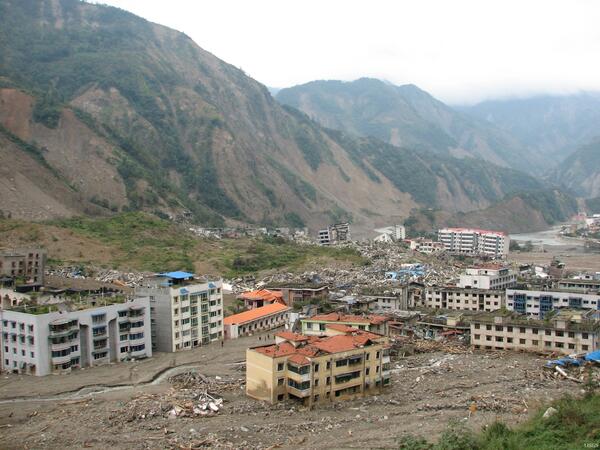"1964 Quake: The Great Alaska Earthquake" is an eleven minute video highlighting the impacts and effects of America's largest recorded earthquake. It is an expanded version of the four minute video "Magnitude 9.2". Both were created as part of USGS activities acknowledging the fifty year anniversary of the quake on March 27, 2014.
Where can I find photographs of earthquake damage?
Two sources for photographs that show earthquake damage are:
-
U.S. Geological Survey Photographic Library (see 'earthquakes' in the categories left column)
Related
At what magnitude does damage begin to occur in an earthquake?
What does an earthquake feel like?
What are those booms I sometimes hear before or during an earthquake?
Why do earthquakes in other countries seem to cause more damage and casualties than earthquakes in the U.S.?
How does an earthquake affect groundwater levels and water quality in wells?
What is liquefaction?
Can you feel an earthquake if you're in a cave? Is it safer to be in a cave during an earthquake?
What are earthquake lights?
How does the USGS tell the difference between an earthquake and a sonic boom?
"1964 Quake: The Great Alaska Earthquake" is an eleven minute video highlighting the impacts and effects of America's largest recorded earthquake. It is an expanded version of the four minute video "Magnitude 9.2". Both were created as part of USGS activities acknowledging the fifty year anniversary of the quake on March 27, 2014.

The May 12, 2008, Great Sichuan Earthquake, also called the Wenchuan Earthquake, occurred at 14:28 local time, in Sichuan Province, China. The earthquake magnitudes were Mw = 7.9 (USGS), Ms = 8.0 (Chinese Earthquake Administration). The epicenter was 80 km west-northwest of Chengdu, the capital city of Sichuan province.
The May 12, 2008, Great Sichuan Earthquake, also called the Wenchuan Earthquake, occurred at 14:28 local time, in Sichuan Province, China. The earthquake magnitudes were Mw = 7.9 (USGS), Ms = 8.0 (Chinese Earthquake Administration). The epicenter was 80 km west-northwest of Chengdu, the capital city of Sichuan province.
Collection of USGS still images taken after the January 17, 1994 Northridge earthquake highlighting the damage to buildings and infrastructure.
Collection of USGS still images taken after the January 17, 1994 Northridge earthquake highlighting the damage to buildings and infrastructure.
Field survey of earthquake effects from the magnitude 4.0 southern Maine earthquake of October 16, 2012
1964 Great Alaska Earthquake: a photographic tour of Anchorage, Alaska
Field survey and damage assessment of the Mineral, Virginia, earthquake of August 23, 2011
Facing the great disaster : How the men and women of the U.S. Geological Survey responded to the 1906 "San Francisco Earthquake"
The October 17, 1989, Loma Prieta, California, earthquake: selected photographs
Photographs from the U.S. Geological Survey Photographic Library (earthquakes, volcanoes, geologic hazards, and other phenomena)
Related
At what magnitude does damage begin to occur in an earthquake?
What does an earthquake feel like?
What are those booms I sometimes hear before or during an earthquake?
Why do earthquakes in other countries seem to cause more damage and casualties than earthquakes in the U.S.?
How does an earthquake affect groundwater levels and water quality in wells?
What is liquefaction?
Can you feel an earthquake if you're in a cave? Is it safer to be in a cave during an earthquake?
What are earthquake lights?
How does the USGS tell the difference between an earthquake and a sonic boom?
"1964 Quake: The Great Alaska Earthquake" is an eleven minute video highlighting the impacts and effects of America's largest recorded earthquake. It is an expanded version of the four minute video "Magnitude 9.2". Both were created as part of USGS activities acknowledging the fifty year anniversary of the quake on March 27, 2014.
"1964 Quake: The Great Alaska Earthquake" is an eleven minute video highlighting the impacts and effects of America's largest recorded earthquake. It is an expanded version of the four minute video "Magnitude 9.2". Both were created as part of USGS activities acknowledging the fifty year anniversary of the quake on March 27, 2014.

The May 12, 2008, Great Sichuan Earthquake, also called the Wenchuan Earthquake, occurred at 14:28 local time, in Sichuan Province, China. The earthquake magnitudes were Mw = 7.9 (USGS), Ms = 8.0 (Chinese Earthquake Administration). The epicenter was 80 km west-northwest of Chengdu, the capital city of Sichuan province.
The May 12, 2008, Great Sichuan Earthquake, also called the Wenchuan Earthquake, occurred at 14:28 local time, in Sichuan Province, China. The earthquake magnitudes were Mw = 7.9 (USGS), Ms = 8.0 (Chinese Earthquake Administration). The epicenter was 80 km west-northwest of Chengdu, the capital city of Sichuan province.
Collection of USGS still images taken after the January 17, 1994 Northridge earthquake highlighting the damage to buildings and infrastructure.
Collection of USGS still images taken after the January 17, 1994 Northridge earthquake highlighting the damage to buildings and infrastructure.












